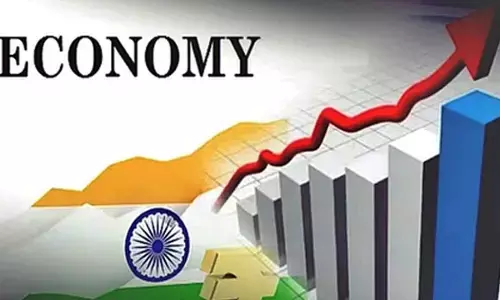Whose ‘developed country’ will it be?

The buzzword these days in India is a ‘developed country’; more precisely that India must attain such a status by the year of its centenary, 2047
The buzzword these days in India is a ‘developed country’; more precisely that India must attain such a status by the year of its centenary, 2047. India now comes under the category of ‘low-middle-income country’. According to the United Nations, there are 37 countries in the world that qualify to that economic eminence, mostly in Europe and North America.
Though there is no precise definition, it commonly denotes a country that is industrialized, and has a high quality of life, an advanced economy, and sophisticated technological infrastructure. As of now, we have none of the above. As estimated by NITI Aayog, India should be, by 2047, a $30 trillion economy with a per-capita income of $20,000.
To achieve these objectives, India’s economy will have to grow nine times from the current level of $3.3 trillion, and per-capita income must grow eight times from the current level of $2,392 per annum. India is in nominal terms the fifth biggest economy in the world today, and expected to be the third very soon.
The paradox is that we aspire to be a ‘developed country’ just when many thoughtful people in such countries — disenchanted with what being a ‘developed country’ has meant to their lives: moral vacuousness, obscene inequalities, ‘mad materialism’, consumptive consumerism, and catastrophic climate crisis — are yearning for alternatives, and looking to countries like India. But India, on the other hand, wants more of the very things that they want to be rid of.
The score card
There is little doubt that India has economically achieved much, especially in the last two decades, and it is churlish to ignore it or underplay it. Numbers and percentages apart, India has dramatically brought down its poverty rate; it has equally improved its physical as well as living infrastructure, and delivery of basic needs and services, and has enhanced life expectancy. Its GDP has soared high, and is now the fifth highest in the world, and soon to be the third. And so on. However, India’s rank in the world for GDP per capita is 129th out of about 200 countries, which is a better reflection of where we are than GDP per se.
According to the World Bank, India may be the fastest growing major economy, but it will take 75 years for its per-capita income to reach even a quarter of US income levels, if current trends continue. Even the ‘per capita’ is not all that accurate. The majority of Indians live far below the national ‘average’. Moreover, India fares poorly on many global key indices and metrics, such as the UN Human Development Index.
According to a study, it is off target in 19 of 33 — more than half — UN sustainable development indicators on critical issues such as health and access to basic services. India lags behind even sub-Saharan Africa in malnutrition, and over 70% of our population cannot afford a nutritional diet. India is the third most polluted country in the world, and its very capital is the most polluted city in the world. Perhaps the most heart-rending, it is said that 114 million people will remain poor forever; their next generation inheriting the same level of poverty.
At the other extreme, we might not yet be a ‘developed country’, but globally we rank very high in two dubious directions: 3.4 lakh Indians are among the top 1 percent of the world’s richest. India’s top 1 percent income share is among the very highest in the world. The number of billionaires in India is the third highest in the world, a dramatic rise from one in 1991.
Ploughing on, the richest 10,000 Indians have an average income of 480 million rupees ($5.7m) a year — more than 2,000 times the average income of Indians. According to one estimate, the population of affluent Indians (with an annual per capita income of more than $10,000) will increase from 60 million in 2023, to 100 million by 2027. It virtually means that the ‘new class’ of Indians are already de facto living in one of the many ‘mini-developed countries’ strewn across the country.
Finally
It is in this setting and with this scorecard that we must review our aim to leapfrog into a developed country. If we commit India to becoming a developed country, and put all our mind and might behind that objective, what could then happen is that India’s internal ‘developed world’ will look more like the more affluent parts of western society, and its internal ‘developing world’ would possibly be marginally better-off, but fall far farther behind its own more fortunate and wealthy fellow citizens.
The cardinal error India made was to continue with the post-liberalization paradigm beyond its utility. It was an emergency measure intended to save the economy. While it served the purpose and put India on the course of growth, it also created intolerable imbalances and unfairness in both burden-sharing and reaping the fruits of its rapid economic growth. We should have changed the course once those came to light. We didn’t because those very incongruities created powerful vested interests. Instead of changing the attendant policy structure, what we did, to paraphrase Einstein, is to try to resolve the problems with the same mindset that created them.
It is the mindset that matters, and it must change in two directions. One, economic growth is vital but it is not standalone. If it is treated that way, it will cause more harm than good. Second, we must understand that our diversity has a development dimension. Economic efficiency and equity in India is not possible if India is conceptualized into one single, smooth and seamless unit. Prioritization and effective delivery is possible only through grassroots governance. India must focus on two things: (1) lifting the lives of the ‘most-needy’ across all divides like caste and religion; and (2) erasing or blurring the borders between the affluent people and the average people, and between our many mini-developed countries and the vast developing word within India.
While uniformity is impossible, it is intolerable that almost 90% of its people lead lives that are diminished for want of adequate purchasing power, which is primarily a policy failure. Equally true is that the ‘New Class’ does so little to share their good fortune with the less fortunate of their countrymen. Being wealthy is no sin, but the way they earn and use their opulence must not only be lawful but righteous. Not only does it not happen in today’s reality, but it is also the fountainhead of political corruption and illegal electoral funding. All these flaws and faults are more likely to sharpen than soften if we make ‘becoming a developed country’ our holy grail.
The key point to bear in mind is that in choosing to become a developed country — which seems so unexceptionable, if not seductive — the nation is making pregnant policy choices with serious consequences that affect different people differently. This was what Gandhi warned against, as another symptom of our western mindset. The ‘New Class’ is already there; the poor, too feeble even to protest. It is the middle class which is licking its lips in anticipation.
Nor is aiming to be a developed country necessary, either to improve people’s lives or to wield global clout. China is an economic superpower without becoming a developed country, and it is actually lending and investing in some big developed countries. It is a country that is both envied and feared. Further, with our dharmic heritage, we can’t ignore India’s moral dimension. Will it make India more callous, or will it lead to a more humane society? Now is the time to ponder over such questions, and have a national conversation. And to make India move in the desirable direction, what can each of us individually and collectively do?
(Writer is a retired IAS officer)



















